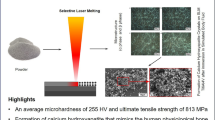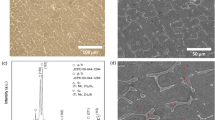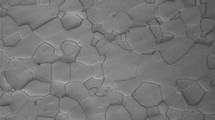Abstract
A technology was developed to obtain homogeneous Ti–30Nb–13Ta–5Zr alloy. The alloy was shown to consist of a pure β-crystalline phase and possesses requisite mechanical properties. The alloy surface exhibits micro- and nanoscale structures. In terms of the ability to generate reactive oxygen species and long-lived reactive protein species, Ti–30Nb–13Ta–5Zr alloy is more favorable compared to nitinol. A high mitotic index (2%) and low content of non-viable cells (< 5%) were observed when growing cell cultures on Ti–30Nb–13Ta–5Zr alloy scaffolds. Cells readily attach and spread over the alloy surface. The biocompatibility of Ti–30Nb–13Ta–5Zr was confirmed by the results of implantation of the alloy in the form of plates or looped wire. Surface morphology of the samples showed no significant changes after biological testing. It can be assumed that Ti–30Nb–13Ta–5Zr is a material potentially suitable for use in medicine.
Graphical abstract








Similar content being viewed by others
References
Gluck T (2011) Report on the positive results obtained by the modern surgical experiment regarding the suture and replacement of defects of superior tissue, as well as the utilization of re-absorbable and living tamponade in surgery. Clin Orthop Relat Res 469:1528–1535
Katz D, O’Toole G, Cogswell L, Sauzieres P, Valenti P (2007) A history of the reverse shoulder prosthesis. Int J Shoulder Surg 1:108–113
Ghoul WE, Chidiac JJ (2012) Prosthetic requirements for immediate implant loading: a review. J Prosthodont 21:141–154
Condon R, Beder O (1964) A study of titanium implants in a corrosion-producing environment. Surgery 55:714–717
Niinomi M (2018) Recent progress in research and development of metallic structural biomaterials with mainly focusing on mechanical biocompatibility. Mater Trans 59(1):11–13
Trino LD, Bronze-Uhle ES, Ramachandran A, Lisboa-Filho PN, Mathew MT, George A (2018) Titanium surface bio-functionalization using osteogenic peptides: surface chemistry, biocompatibility, corrosion and tribocorrosion aspects. J Mech Beh Biomed Mater 81:26–38
Duerig T, Pelton A, Stöckel D (1999) An overview of nitinol medical applications. Mater Sci Eng, A 273–275:149–160
Sanghvi N, Crasta F, Kottur VKN (2019) Review of application of nitinol in the manufacture of bone staples. In: Vasudevan H, Kottur V, Raina A (eds) Proceedings of international conference on intelligent manufacturing and automation. Lecture notes in mechanical engineering. Springer, Singapore
Saito M, Arakaki R, Yamada A, Tsunematsu T, Kudo Y, Ishimaru N (2016) Molecular mechanisms of nickel allergy. Int J Mol Sci 17:E202
Ranganathan S (2003) Alloyed pleasures: multimetallic cocktails. Curr Sci 85:1404–1406
Shimojo N, Kondo C, Yamashita K, Hoshino T, Hayakawa T (2007) Cytotoxicity analysis of a novel titanium alloy in vitro: adhesion, spreading, and proliferation of human gingival fibroblasts. Biomed Mater Eng 17(2):127–135
Choi K, Kim M, Zhu J, Zhang F, Song Y, Yi S, Park JS (2018) Collapse of lamellar structure and stability with the addition of Misch metal (Mm) to the cast Ti–Al–Mo–Nb–(Mm) alloys. J Mater Sci 53:12504–12511. https://doi.org/10.1007/s10853-018-2439-5
Xu R, Liu B, Yan Z, Chen F, Guo W, Liu Y (2019) Low-cost and high-strength powder metallurgy Ti–Al–Mo–Fe alloy and its application. J Mater Sci 54:12049–12060. https://doi.org/10.1007/s10853-019-03734-y
Dai J, Xia J, Chai L, Murty KL, Guo N, Daymond MR (2020) Correlation of microstructural, textural characteristics and hardness of Ti–6Al–4 V sheet β-cooled at different rates. J Mater Sci 55:8346–8362. https://doi.org/10.1007/s10853-020-04603-9.pdf
Biesiekierski A, Wang J, Gepreel M, Wen C (2012) A new look at biomedical Ti-based shape memory alloys. Acta Biomater 8(5):1661–1669
Ozan S, Lin J, Li Y, Wen C (2017) New Ti–Ta–Zr–Nb alloys with ultrahigh strength for potential orthopedic implant applications. J Mech Behav Biomed Mater 75:119–127
Preisler D, Janeček M, Harcuba P, Džugan J, Halmešová K, Málek J, Veverková A, Stráský J (2019) The effect of hot working on the mechanical properties of high strength biomedical Ti–Nb–Ta–Zr–O alloy. Materials (Basel) 12(24):E4233
Eisenbarth E, Velten D, Muller M, Thull R, Breme J (2004) Biocompatibility of b-stabilizing elements of titanium alloys. Biomaterials 25(26):5705–5713
Murray JL (1981) The Ta − Ti (Tantalum–Titanium) system. Bull Alloy Phase Diagr 2:62–66
Sergienko KV, Sevost’yanov MA, Konushkin SV, Nasakina EO, Baikin AS, Shatova LA, Kolmakov AG (2018) Investigation of static properties of medical alloys Ti–(20–30)Nb–(10–13)Ta–5Zr. IOP Conf Ser Mater Sci Eng 347:012049
Magdalen HC, Baghi AD, Ghomashchi R, Xiao W, Oskouei RH (2019) Effect of niobium content on the microstructure and Young’s modulus of Ti–xNb–7Zr alloys for medical implants. J Biomed Mater 99:78–85
Fanton L, Cremasco A, Mello MG, Caram R (2019) Anodization growth of TiO2 nanotubes on Ti–35Nb–7Zr–5Ta alloy: effects of anodization time, strain hardening, and crystallographic texture. J Mater Sci 54:13724–13739. https://doi.org/10.1007/s10853-019-03870-5
Soro N, Attar H, Brodie E, Veidt M, Molotnikov A, Dargusch MS (2019) Evaluation of the mechanical compatibility of additively manufactured porous Ti–25Ta alloy for load-bearing implant applications. J Mech Behav Biomed Mater 97:149–158
Li Z, Zheng B, Wang Y, Topping T, Zhou Y, Valiev RZ, Shan A, Lavernia EJ (2014) Ultrafine-grained Ti–Nb–Ta–Zr alloy produced by ECAP at room temperature. J Mater Sci 49:6656–6666. https://doi.org/10.1007/s10853-014-8337-6
Sharapov MG, Novoselov VI, Penkov NV, Fesenko EE, Vedunova MV, Bruskov VI, Gudkov SV (2019) Protective and adaptogenic role of peroxiredoxin 2 (Prx2) in neutralization of oxidative stress induced by ionizing radiation. Free Radic Biol Med 134:76–86
Chernikov AV, Gudkov SV, Shtarkman IN, Bruskov VI (2007) Oxygen effect in heat-mediated damage to DNA. Biofizika 52(2):244–251
Shtarkman IN, Gudkov SV, Chernikov AV, Bruskov VI (2008) Effect of amino acids on X-ray-induced hydrogen peroxide and hydroxyl radical formation in water and 8-oxoguanine in DNA. Biochemistry (Mosc) 73(4):470–478
Gudkov SV, Guryev EL, Gapeyev AB, Sharapov MG, Bunkin NF, Shkirin AV, Zabelina TS, Glinushkin AP, Sevost’yanov MA, Belosludtsev KN, Chernikov AV, Bruskov VI, Zvyagin AV (2019) Unmodified hydrated C(60) fullerene molecules exhibit antioxidant properties, prevent damage to DNA and proteins induced by reactive oxygen species and protect mice against injuries caused by radiation-induced oxidative stress. Nanomedicine 15(1):37–46
Chernov AS, Reshetnikov DA, Kovalitskaya YuA, Manokhin AA, Gudkov SV (2018) Influence of wideband visible light with an padding red component on the functional state of mice embryos and embryonic stem cells. J Photochem Photobiol, B 188:77–86
Sevost’yanov MA, Nasakina EO, Baikin AS, Sergienko KV, Konushkin SV, Kaplan MA, Seregin AV, Leonov AV, Kozlov VA, Shkirin AV, Bunkin NF, Kolmakov AG, Simakov SV, Gudkov SV (2018) Biocompatibility of new materials based on nano-structured nitinol with titanium and tantalum composite surface layers: experimental analysis in vitro and in vivo. J Mater Sci Mater Med 29(3):33
Kaplan MA, Sergienko KV, Kolmakova AA, Konushkin SV, Baikin AS, Kolmakov AG, Sevostyanov MA, Kulikov AV, Ivanov VE, Belosludtsev KN, Antipov SS, Volkov MY, Shusharina NN, Karaduleva EV, Kozlov VA, Simakin AV, Gudkov SV (2020) Development of a biocompatible PLGA polymers capable to release thrombolytic enzyme prourokinase. J Biomater Sci Polym Ed. https://doi.org/10.1080/09205063.2020.1760699
Leventhal GS (1951) Titanium, a metal for surgery. J Bone Jt Surg Am 33:473–474
García-Martínez E, Miguel V, Martínez-Martínez A, Manjabacas MC, Coello J (2019) Sustainable lubrication methods for the machining of titanium alloys: an overview. Materials (Basel) 12(23):E3852
Barras CD, Myers KA (2000) Nitinol: its use in vascular surgery and other applications. Eur J Vasc Endovasc Surg 19(6):564–569
Shabalovskaya SA (1996) On the nature of the biocompatibility and on medical applications of NiTi shape memory and superelastic alloys. Biomed Mater Eng 6(4):267–289
Di Gioacchino M, Ricciardi L, De Pità O, Minelli M, Patella V, Voltolini S, Di Rienzo V, Braga M, Ballone E, Mangifesta R, Schiavino D (2014) Nickel oral hyposensitization in patients with systemic nickel allergy syndrome. Ann Med 46(1):31–37
Cheng X, Liu S, Chen C, Chen W, Liu M, Li R, Zhang X, Zhou K (2019) Microstructure and mechanical properties of additive manufactured porous Ti–33Nb–4Sn scaffolds for orthopaedic applications. J Mater Sci Mater Med 30:91
Zhou YL, Niinomi M (2009) Ti–25Ta alloy with the best mechanical compatibility in Ti–Ta alloys for biomedical applications. Mater Sci Eng, C 29(3):1061–1065
Nasakina EO, Konushkin SV, Baskakova MI, Fedyuk IM, Sergienko KV, Baikin AS, Kaplan MA, Sevostyanov MA, Kolmakov AG (2018) The production of a thin wire of Ti–Nb–Ta–Zr shape memory alloy for medical devices. J Mater Sci Eng 7(2):430–436
Burton M (1950) Radiation chemistry. Ann Rev Phys Chem 1:113–132
Gudkov SV, Andreev SN, Barmina EV, Bunkin NF, Kartabaeva BB, Nesvat AP, Stepanov EV, Taranda NI, Khramov RN, Glinushkin AP (2017) Effect of visible light on biological objects: physiological and pathophysiological aspects. Phys Wave Phenom 25(3):207–213
Neyens E, Baeyens J (2003) A review of classic Fenton’s peroxidation as an advanced oxidation technique. J Hazard Mater 98(1–3):33–50
Gudkov SV, Chernikov AV, Bruskov VI (2016) Chemical and radiological toxicity of uranium compounds. Rus J Gen Chem 86(6):1531–1538
Boldinova EO, Wanrooij PH, Shilkin ES, Wanrooij S, Makarova AV (2017) DNA damage tolerance by eukaryotic DNA polymerase and primase PrimPol. Int J Mol Sci 18(7):E1584
Filev AD, Shmarina GV, Ershova ES, Veiko NN, Martynov AV, Borzikova MA, Poletkina AA, Dolgikh OA, Veiko VP, Bekker AA, Chirkov AV, Volynshchikov ZN, Deviataikina AS, Shashin DM, Puretskiy VK, Tabakov VJ, Izhevskaya VL, Kutsev SI, Kostyuk SV, Umriukhin PE (2019) Oxidized cell-free DNA role in the antioxidant defense mechanisms under stress. Oxid Med Cell Longev 2019:1245749
Bruskov VI, Malakhova LV, Masalimov ZK, Chernikov AV (2002) Heat-induced formation of reactive oxygen species and 8-oxoguanine, a biomarker of damage to DNA. Nucl Acids Res 30(6):1354–1363
Moldogazieva NT, Mokhosoev IM, Mel’nikova TI, Porozov YB, Terentiev AA (2019) Oxidative stress and advanced lipoxidation and glycation end products (ALEs and AGEs) in aging and age-related diseases. Oxid Med Cell Longev 2019:3085756
Fenton HJH (1894) Oxidation of tartaric acid in presence of iron. J Chem Soc Trans 65:899–911
Toyokuni S (1996) Iron-induced carcinogenesis: the role of redox regulation. Free Radic Biol Med 20(4):553–566
Bruskov VI, Karp OE, Garmash SA, Shtarkman IN, Chernikov AV, Gudkov SV (2012) Prolongation of oxidative stress by long-lived reactive protein species induced by X-ray radiation and their genotoxic action. Free Radic Res 46(10):1280–1290
Kasemo B (1983) Biocompatibility of titanium implants: surface science aspects. J Prosthet Dent 49(6):832–837
Johansson CB, Albrektsson T (1991) A removal torque and histomorphometric study of commercially pure niobium and titanium implants in rabbit bone. Clin Oral Implants Res 2(1):24–29
Wang Q, Zhang H, Li Q, Ye L, Gan H, Liu Y, Wang H, Wang Z (2015) Biocompatibility and osteogenic properties of porous tantalum. Exp Ther Med 9(3):780–786
Saldaña L, Méndez-Vilas A, Jiang L, Multigner M, González-Carrasco JL, Pérez-Prado MT, González-Martín ML, Munuera L, Vilaboa N (2007) In vitrobiocompatibility of an ultrafine grained zirconium. Biomaterials 28(30):4343–4354
Acknowledgements
The authors would like to thank Dr. Alexey Berezhnov for helping with cell cultures and Prof. Alexander Kulikov for help with animal treatment. The authors are grateful to the Center for Collective Use of the GPI RAS for the equipment provided.
Author information
Authors and Affiliations
Corresponding author
Ethics declarations
Conflict of interest
The authors report no conflict of interest. The authors alone are responsible for the content and writing of the paper.
Additional information
Publisher's Note
Springer Nature remains neutral with regard to jurisdictional claims in published maps and institutional affiliations.
Rights and permissions
About this article
Cite this article
Sevostyanov, M.A., Kolmakov, A.G., Sergiyenko, K.V. et al. Mechanical, physical–chemical and biological properties of the new Ti–30Nb–13Ta–5Zr alloy. J Mater Sci 55, 14516–14529 (2020). https://doi.org/10.1007/s10853-020-05020-8
Received:
Accepted:
Published:
Issue Date:
DOI: https://doi.org/10.1007/s10853-020-05020-8




